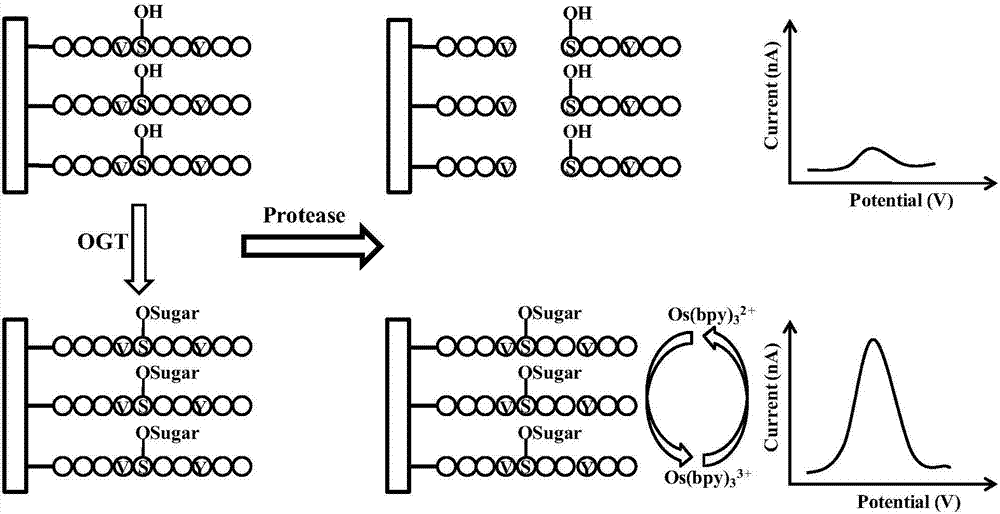Electrochemical sensing detection method of protein O-GlcNAc glycosyltransferase activity
A technology of glycosyltransferase and detection method, which is applied in the direction of material electrochemical variables, measuring devices, scientific instruments, etc., can solve problems such as complicated operation, non-universal applicability, and inability to meet actual requirements, and achieve simple operation steps and high efficiency. The effect of sensitivity
- Summary
- Abstract
- Description
- Claims
- Application Information
AI Technical Summary
Problems solved by technology
Method used
Image
Examples
preparation example Construction
[0055] 2. Preparation of metal / organic ligands
[0056] In a 50ml round bottom flask, add 0.25g (NH 4 ) 2 [OsCl] 6 (0.56mM) and 0.262g 2,2'-bipyridine (1.68mM), the reaction solvent is 30ml ethylene glycol, in the environment of nitrogen protection, under the condition of oil bath heating and rapid stirring, react for one hour, then cool to room temperature , will contain 1.68mM NH 4 PF 6 The aqueous solution was added to the cooled reaction solution to obtain the target product as a dark green precipitate, which was then recrystallized with a mixed solution of cold water and ethylene glycol. The obtained product was separated and purified by an activated neutral alumina chromatography column (acetonitrile as the mobile phase), and the dark green band part was collected, and then recrystallized with a mixed solvent of acetone and diethyl ether. Get the final product as [Os(bpy) 3 ](PF 6 ) 2 . The obtained reaction products were characterized by mass spectrometry, ultr...
Embodiment 1
[0059] 1. Functional modification of the surface of semiconductor electrodes
[0060] For functional modification of the surface of indium tin oxide (ITO) electrodes, the modifiers that can be used are generally organic compounds with poor conductivity, which may inhibit the electrochemical response of the electron mediator. The surface of the electrode was modified by silanization in different degrees, and the ITO electrode was placed in a toluene solution containing 1vv% 3-glycidyl etheroxypropyltrimethoxysilane to react for different times (0.5, 1, 2, 4, 8, 10, 12, 16, 20, 24 hours). After the reaction is completed, ultrasonically sonicate in toluene and absolute ethanol for 5 minutes respectively, then blow dry with nitrogen gas, and bake in a muffle furnace at 115° C. for 20 hours. X-ray photoelectron spectroscopy (XPS) showed that the surface content of the modifiers increased with the modification reaction time. Although the modification layer has obvious inhibitory e...
PUM
 Login to View More
Login to View More Abstract
Description
Claims
Application Information
 Login to View More
Login to View More - R&D
- Intellectual Property
- Life Sciences
- Materials
- Tech Scout
- Unparalleled Data Quality
- Higher Quality Content
- 60% Fewer Hallucinations
Browse by: Latest US Patents, China's latest patents, Technical Efficacy Thesaurus, Application Domain, Technology Topic, Popular Technical Reports.
© 2025 PatSnap. All rights reserved.Legal|Privacy policy|Modern Slavery Act Transparency Statement|Sitemap|About US| Contact US: help@patsnap.com


